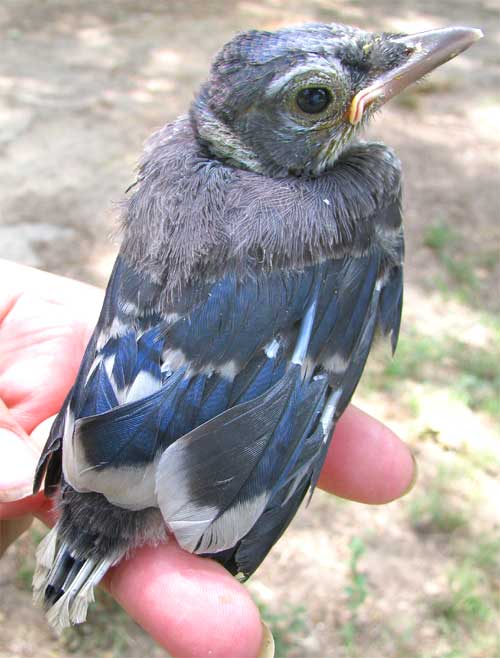Excerpts from Jim Conrad's
Naturalist Newsletter
from the June 9, 2008 Newsletter, issued from the forest near Natchez, Mississippi; elevation ~400ft (120m), ~N31.47°, ~W91.29°:
A BLUE JAY NESTLING
Thursday morning during my breakfast campfire Maggie the dog carried something from beneath a nearby trailer. It was a Blue Jay nestling.
Philosophically when I'm confronted with truly homeless nestlings my attitude is pretty cold: Without its parents' support the nestling is doomed, and even if I could nurse it until it could fly away, it would probably starve since it wouldn't have been taught what to eat. Plus it would carry some dangerous assumptions with it, namely, that humans are to be trusted.
Therefore, in most cases, it's just best to not intervene, unless you recognize that the main beneficiary would be you, not the bird, for interacting with small animals can come to mean a lot to a human.
But Thursday morning I hadn't thought through any of that before I'd rushed over and extricated the nestling from Maggie's mouth. The only damage seemed to be a single dislodged wing-feather.
Now what?
Happily, my host Karen has a long history of saving abandoned critters, especially birds, so I turned the problem over to her. She already had special store-bought formula for feeding baby birds on hand so before I knew it she'd warmed up a pasty gruel rich in the vitamins growing birds need, and was feeding the bird with a medicine dropper.
You can see the nestling perched on Karen's finger below:

An interesting feature of the nestling was that its plumage consisted of both fuzzy down feathers typical of baby birds, and sprouting "contour feathers," which are the stiff, often colorful feathers covering mature birds.

Above you can see a close-up of the beginnings of the nestling's tail. Note how the feathers emerge from hard, plastic, hollow, strawlike things. The "straws" are anchored in the nestling's body and constitute the feathers' future quills.
from the February 1, 2004 Newsletter, issued from near Natchez, Mississippi:
BLUE JAY COURTSHIP FLOCKS
Nowadays on warmish, sunny mornings, sometimes I hear Blue Jays making strange rattle-calls. If I watch the spot where the calls originate eventually I see a flock of five to eight jays flying away. These small flocks and rattle-calls are part of the jays' early-season courtship behavior.
During fall, Blue Jays, CYANOCITTA CRISTATA, join into large, roaming flocks evenly divided among males and females. When cold weather arrives they break into smaller flocks of maybe four to six birds. With the first stirrings of spring, Blue Jays form "courtship flocks" consisting of three to ten birds moving about as a group in an area of one-quarter to a square mile (0.65 - 2.6 ha). Though males and females are identical, it's believed that courtship flocks consist of one female, with the rest being males. The female basically leads the males around, whether it's shifting from the middle to the top of a tree, or flying across a field.
The question at this time of year is then whether a particular flock is a general cold-weather, mixed-sex flock, or a newly constituted courtship flock. To decide, you must look for courtship behavior.
One typical piece of courtship behavior is the "bobbing display," which often is accompanied by the "toolool-call" or the "rattle-call." Bobbing consists of the bird quickly and repeatedly raising and lowering its whole body by extending its legs. The "toolool-call" is a two-part, monotonal, bell-like call, and the "rattle-call" is a dry, nonmusical rattle.
Therefore, since I'm hearing the rattle-call, I'm assuming that my little flocks are courtship flocks.
Once we read about these behaviors and calls, often we think, "Oh, I've seen that! I've heard that!" It's just that we need to have someone draw our attention to these things, and to explain what they mean. Several excellent books, particularly those by Donald Stokes, focus on bird behavior. These book can enhance our backyard birdwatching enormously.